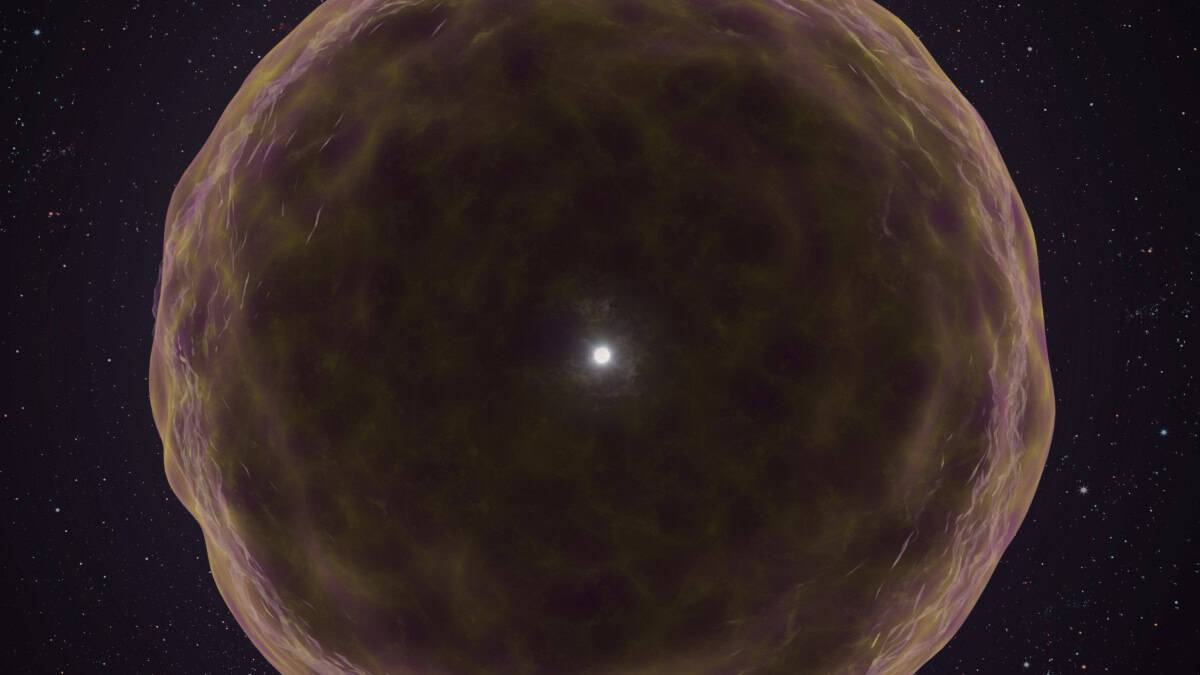Science
Astronomers Identify Heavily Stripped Star Before Supernova

For the first time, astronomers have detected a heavily stripped star that shed many of its outer layers prior to its supernova explosion. This significant discovery, led by Steve Schulze from Northwestern University, reveals spectral signatures of heavy elements that are typically concealed deep within stellar interiors.
Inside stars, atomic nuclei undergo a fusion process called nucleosynthesis, creating heavier elements while releasing energy that counteracts gravitational forces. As stars age, they transition through various stages of element production. “Observations and models of stars tell us that stars are enormous balls of hydrogen when they are born,” Schulze explains. In the core, hydrogen fuses into helium, which then fuses into carbon, progressing up to iron.
Aging stars often assume an onion-like structure, with an outer hydrogen shell enveloping layers of increasingly heavier elements. As a star nears the end of its life, inner-shell elements such as silicon, sulphur, and argon fuse to form an iron core. Unlike lighter elements, iron fusion consumes energy, leaving the star incapable of resisting its own gravity. This results in a rapid collapse followed by a spectacular explosion.
Observing hidden elements in a dying star remains a rare occurrence. When a supernova occurs, heavier elements that are usually buried in deeper layers can create absorption lines in the light spectrum, enabling astronomers to ascertain the compositions of these inner layers. Previous studies have identified elements as heavy as carbon and oxygen, but direct evidence of even deeper layers had not been documented until now.
In 2021, a notable observation was made by the Zwicky Transient Facility, led by Avishay Gal-Yam at the Weizmann Institute of Science in Israel. The team was actively scanning the sky for signs of infant supernovae shortly after their initial explosions. On September 7, 2021, Schulze noted a rapid increase in brightness in a newly discovered supernova designated SN 2021yfj. He promptly contacted Alex Filippenko’s group at the University of California, Berkeley for a spectral analysis.
When the results arrived, the team was astonished to find that the absorption lines in the supernova’s spectrum were unlike anything previously encountered. “We initially had no idea that most of the features in the spectrum were produced by silicon, sulphur, and argon,” Schulze stated. Gal-Yam took on the task of identifying these unusual spectral features.
In the meantime, researchers conducted simultaneous observations of SN 2021yfj using various ground and space-based telescopes. Following Gal-Yam’s analysis, the data corroborated a significant finding. “We had detected a supernova embedded in a shell of material rich in silicon, sulphur, and argon,” Schulze described. These elements are typically formed shortly before a star’s death and are often obscured by other materials.
This discovery provides compelling evidence that the star had undergone more extensive stripping of its outer layers than previously observed. “SN 2021yfj demonstrates that stars can die in far more extreme ways than previously imagined,” Schulze remarked. “It reveals that our understanding of how stars evolve and die is still not complete, despite billions of them having already been studied.”
The research is detailed in the journal Nature. By analyzing these results, astronomers hope to enhance their understanding of the latter stages of stellar evolution and the processes leading to such dramatic ends.
-

 Health2 months ago
Health2 months agoNeurologist Warns Excessive Use of Supplements Can Harm Brain
-

 Health2 months ago
Health2 months agoFiona Phillips’ Husband Shares Heartfelt Update on Her Alzheimer’s Journey
-

 Science7 days ago
Science7 days agoBrian Cox Addresses Claims of Alien Probe in 3I/ATLAS Discovery
-

 Science5 days ago
Science5 days agoNASA Investigates Unusual Comet 3I/ATLAS; New Findings Emerge
-

 Science2 days ago
Science2 days agoScientists Examine 3I/ATLAS: Alien Artifact or Cosmic Oddity?
-

 World2 months ago
World2 months agoCole Palmer’s Cryptic Message to Kobbie Mainoo Following Loan Talks
-

 Entertainment3 months ago
Entertainment3 months agoKerry Katona Discusses Future Baby Plans and Brian McFadden’s Wedding
-

 Entertainment3 months ago
Entertainment3 months agoEmmerdale Faces Tension as Dylan and April’s Lives Hang in the Balance
-

 Entertainment3 months ago
Entertainment3 months agoLove Island Star Toni Laite’s Mother Expresses Disappointment Over Coupling Decision
-

 Entertainment2 months ago
Entertainment2 months agoMajor Cast Changes at Coronation Street: Exits and Returns in 2025
-

 World2 months ago
World2 months agoCoronation Street’s Asha Alahan Faces Heartbreaking Assault
-

 Entertainment2 weeks ago
Entertainment2 weeks agoStefan Dennis and Dianne Buswell Share Health Update on Strictly Come Dancing









